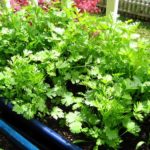Coriander, also known as Chinese parsley, is a versatile herb used in a variety of dishes and can be consumed raw. It not only enhances the flavor of food but also boasts medicinal properties, effective in treating ailments such as runny nose, chest congestion, digestive issues, and appendicitis. Growing coriander at home ensures a convenient supply, and harvesting is simple—just pluck the leaves, leaving the roots intact, and the plant will continue to grow.
Best Time to Grow Coriander
Coriander is resilient and adaptable, thriving in various environmental conditions and climates. It grows fastest at temperatures between 20-30°C. While you can plant coriander year-round, avoid periods of extremely low temperatures as this will hinder its growth. Spring and autumn are the ideal seasons for optimal growth.

Grow your own coriander at home.
Preparing Coriander Seeds or Seedlings
There are two methods to growing coriander: using seedlings or seeds. If you opt for seedlings, choose healthy, pest-free plants. Coriander seeds are readily available at seed shops and supermarkets, boasting a high germination rate.
Soil Requirements for Coriander
Coriander isn’t picky about soil, growing well in most soil types except highly acidic or saline soils. For optimal growth, use well-aerated, loamy soil rich in organic matter and nutrients.
Ensure the soil is loose and airy, and the pot has adequate drainage holes to prevent waterlogging.
Planting and Caring for Coriander
For seedlings, simply plant them in the soil, covering the roots, and water them. If using seeds, soak them in water until they absorb moisture, then wrap them in a damp cloth until they sprout before planting. If your plants grow rapidly and thrive, regular watering and a small amount of NPK fertilizer should suffice.
Coriander is relatively pest-resistant, so you don’t need to worry about insects too much. However, keep an eye out for ants, which may occasionally infest the plants.

At a certain stage, coriander will flower and produce seeds. You can collect and reuse these seeds for future plantings.
Coriander is quick to harvest—within a month of planting, you can start plucking the leaves, leaving the roots untouched. In about 25-30 days, new leaves will grow to maturity, ready for another harvest. As the plant ages, it may flower and produce seeds, which can be saved for future plantings, replacing older, slower-growing plants.
The Perfect Blend: Mastering the Art of Vietnamese Dipping Sauce for Escargot
Delicious snail fish sauce is an irresistible flavor enhancer. This savory condiment is a must-have for any culinary enthusiast, as it awakens the senses and adds a unique twist to your dishes. The aroma and taste of this sauce are truly exceptional, taking your taste buds on an adventure with every bite.





































